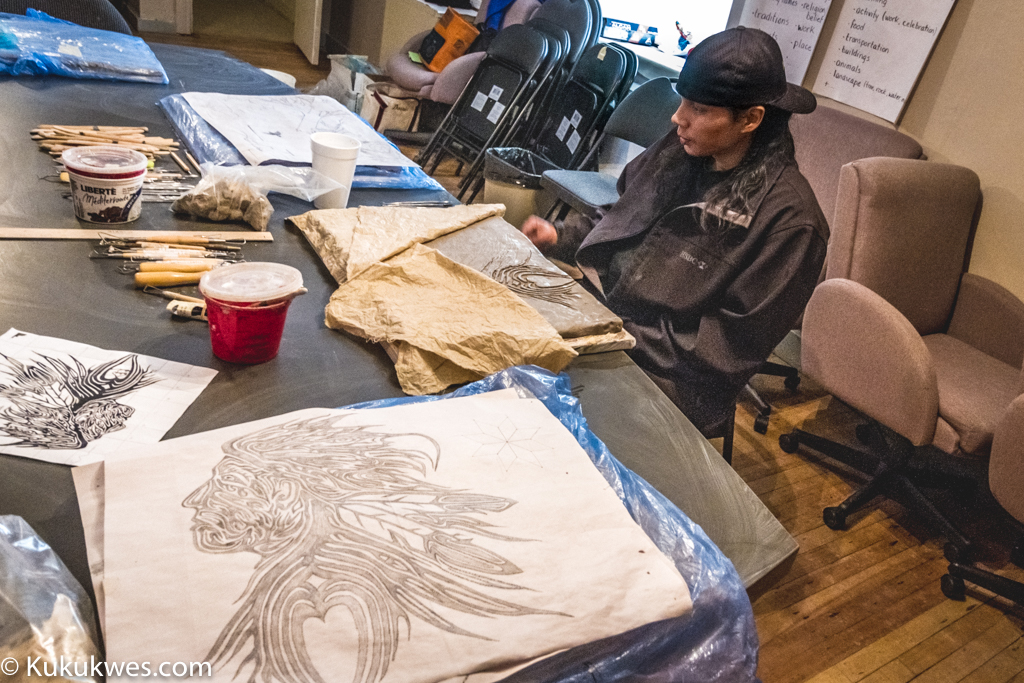
Urban Paul says he experienced a lot of racism after he and his mother moved from the Mi’kmaq community of Eskasoni, N.S. to Halifax when he was five years old.
“Some things were hard to get used to. Some things you never get used to, I guess,” Urban Paul says.
“It was difficult moving up, just being called names,” he adds. “Even with teachers, I felt that I was treated differently.”
Urban Paul, 37, is one of 32 Aboriginal people currently taking part in an art project at the Mi’kmaw Native Friendship Centre aimed at educating the general public about the urban Aboriginal population in Halifax.
The project is called “This is What I Wished You Knew.” Participants create their own drawings and then transfer the image on a piece of clay tile. Once the image is complete, the clay tile is left to dry out for several weeks before it is placed in a kiln and then ready to paint.
Once all of the tiles are complete, they will be used to create a mural at the Mi’kmaw Native Friendship Centre. Each tile will have a QR code embedded into it that will link to an online video of the artist explaining his/her artwork. The mural will remain permanently at the centre.
The tentative date to unveil the mural is in mid-June.
The project was one of six projects across Canada approved through the Canada Council for the Arts (RE) conciliation Initiative which receives funding from the J.W. McConnell Family Foundation and the Circle on Philanthropy and Aboriginal Peoples in Canada.
Michelle Paul, who serves as the project coordinator, says she hopes the project will address the gaps and misunderstandings the mainstream population may have about Aboriginal people in Halifax.
Like Urban Paul, Michelle Paul, 39, is also Mi’kmaq who grew up in Halifax.
“Living as an urban Aboriginal is different than living on the reserve,” Michelle Paul says.
“For me, the only thing that I really have for a sense of belonging and a sense of structure and a sense of home is like, the Mi’kmaw Native Friendship Centre,” Michelle Paul explains.
“Living off reserve, you have to reach out and find those pockets of home and sense of belonging.”
According to Michelle Paul, the project has room for 18 more participants.

Dorrie Brown, a retired art teacher, is assisting participants in creating images through their stories of identity.
“It starts from yourself. Nobody is coming in and suggesting an image to you,” Brown explains.
“It’s starting from your soul and your spirit and your sense of self and from that, we’re pulling out, we’re deriving images.”
Brown says she’s honoured to be part of mural project because she feels she’s on the receiving end of the project’s purpose.
“It’s learning how dynamic this community is in the middle of Halifax and I had no idea,” she says.
Urban Paul’s clay tile is stylized drawing of a woman with images of an eagle and feathers in her long hair. He says he drew the image ten years ago after a close friend passed away.
“She was the coolest person I had known,” Urban Paul says. “She was awesome so I just wanted to do something for her.”
Urban Paul says the drawing also reflects his pride in his identity despite the racism he has experienced in life.
I am proud of who I am, an urban Aboriginal. And I’m proud of this drawing here.”




